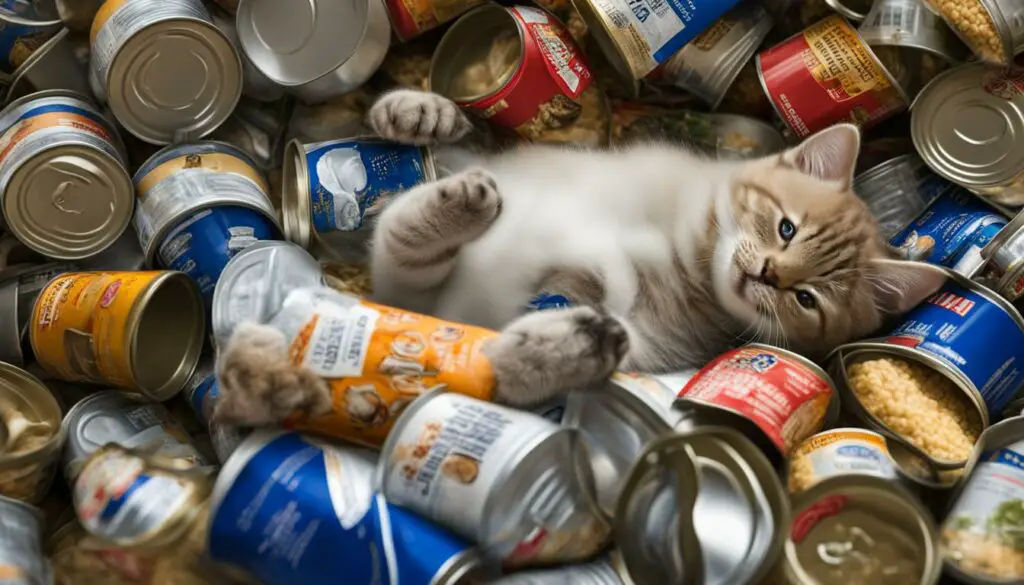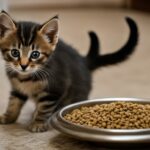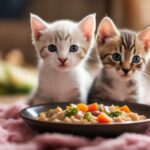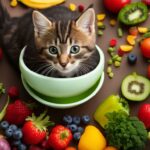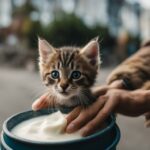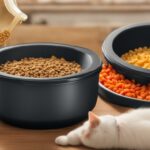As a pet owner, it’s essential to understand the proper nutrition for your kitten’s healthy growth. Feeding your growing feline friend correctly can contribute to their overall well-being, prevent obesity, and ensure optimal development. In this article, I will explore the signs of overfeeding in kittens and provide guidelines for feeding your little furball.
Key Takeaways:
- Overfeeding can lead to overweight or obese kittens.
- Regular weigh-ins and portion control are important for maintaining a healthy weight.
- Kittens grow rapidly and reach adult size at about 40 weeks of age.
- The right amounts of protein, fat, and calcium are crucial for optimal growth.
- Choosing a diet formulated specifically for kittens is recommended.
Normal Growth and Development in Kittens
As kittens grow and develop, their bodies undergo significant changes. Understanding the normal growth patterns in kittens is essential for ensuring their overall health and well-being. Kittens experience rapid growth during their first few weeks of life, doubling or even tripling their birth weight within the first month.
By the time kittens reach 30 weeks of age, they have reached about 80% of their adult size. At this point, their growth rate begins to slow down, and they continue to grow steadily until they reach their full adult size at around 10-12 months of age.
The growth rate of kittens can vary depending on factors such as breed, genetics, nutrition, and the environment. It’s important to provide kittens with proper nutrition to support their growth and development. A balanced diet that meets their specific nutritional needs is crucial for ensuring optimal growth and body composition.
“Proper nutrition is vital for the health and development of kittens, regardless of breed. The nutrient density and amount of food fed play a significant role in achieving optimal growth and body composition.”
Tracking a kitten’s growth progress through regular weigh-ins and working closely with a veterinarian can help ensure that they are growing at a healthy rate. By providing the right nutrients and monitoring their growth, we can help kittens thrive and reach their full potential.
| Weeks of Age | Weight (lbs) |
|---|---|
| 4 | 1-2 |
| 8 | 2-4 |
| 12 | 3-6 |
| 16 | 4-8 |
Optimal vs. Maximal Growth in Kittens
When it comes to the growth of kittens, there are two distinct approaches: optimal growth and maximal growth. Optimal growth refers to a slow and steady rate that allows kittens to reach their ideal adult body condition without becoming overweight or obese. On the other hand, maximal growth involves a rapid growth rate often achieved through high-fat foods, overfeeding, or free-choice feeding.
Optimal growth in kittens is crucial for their long-term health and well-being. It promotes the development of lean muscle mass and helps prevent the risk of obesity, which can lead to various health problems like diabetes and joint issues. By monitoring the growth rate of kittens and ensuring they are not gaining weight too quickly, pet owners can help them achieve their ideal body condition.
Regular assessments of body condition and weight, with the guidance of a veterinarian, are essential for determining if a kitten is growing at an optimal rate. A veterinarian can also provide recommendations on appropriate feeding practices, portion sizes, and the ideal nutritional balance for kittens based on their age and breed.
The Importance of Optimal Growth
Optimal growth sets the stage for a healthier adulthood. It allows kittens to develop strong bones, muscles, and immune systems. It also reduces the risk of obesity-related health issues in the long run. By providing kittens with the right amount of high-quality nutrition and controlling their portion sizes, pet owners can ensure they are growing optimally.
In contrast, maximal growth can have negative consequences. It can put excessive strain on a kitten’s developing bones and joints, leading to skeletal issues and long-term problems. Additionally, rapid weight gain can result in fat deposition and an increased risk of obesity. Therefore, it is important to focus on the goal of optimal growth rather than pursuing maximal growth in kittens.
In summary, opting for optimal growth rather than maximal growth is crucial for the health and well-being of kittens. By providing the right nutrition, monitoring their growth rate, and seeking guidance from a veterinarian, pet owners can ensure that their kittens grow into healthy and happy adult cats.
| Growth Approach | Characteristics |
|---|---|
| Optimal Growth | Slow and steady growth rate |
| Promotes lean muscle mass development | |
| Reduces the risk of obesity | |
| Maximal Growth | Rapid growth rate |
| Puts strain on developing bones and joints | |
| Increased risk of obesity |
Nutritional Requirements for Growing Kittens
Growing kittens have specific nutritional needs to support their rapid growth and development. It is essential to provide them with a balanced diet that meets their protein, fat, and calcium requirements.
The protein requirement for kittens is higher than that of adult cats. Protein plays a crucial role in the growth and development of muscles, tissues, and organs. Kittens need a diet that contains 35-50% protein on a dry matter basis. This ensures they receive the necessary amino acids for optimal growth.
Fat is another important nutrient for kittens. It provides them with energy and helps in the absorption of fat-soluble vitamins. However, excessive fat intake can lead to obesity. Kittens should consume a diet with a fat content of 18-35% on a dry matter basis to promote healthy growth without excess weight gain.
Calcium is vital for the development of strong bones and teeth in growing kittens. It is important to provide them with the right amount of calcium to prevent deficiencies or excesses. The recommended calcium range for kittens is 0.8-1.6% on a dry matter basis.
The Nutritional Requirements for Growing Kittens:
- Protein: 35-50% on a dry matter basis
- Fat: 18-35% on a dry matter basis
- Calcium: 0.8-1.6% on a dry matter basis
Choosing a high-quality diet specifically formulated for kittens ensures that these nutritional requirements are met. It is always best to consult with a veterinarian to determine the most suitable diet for your growing kitten.
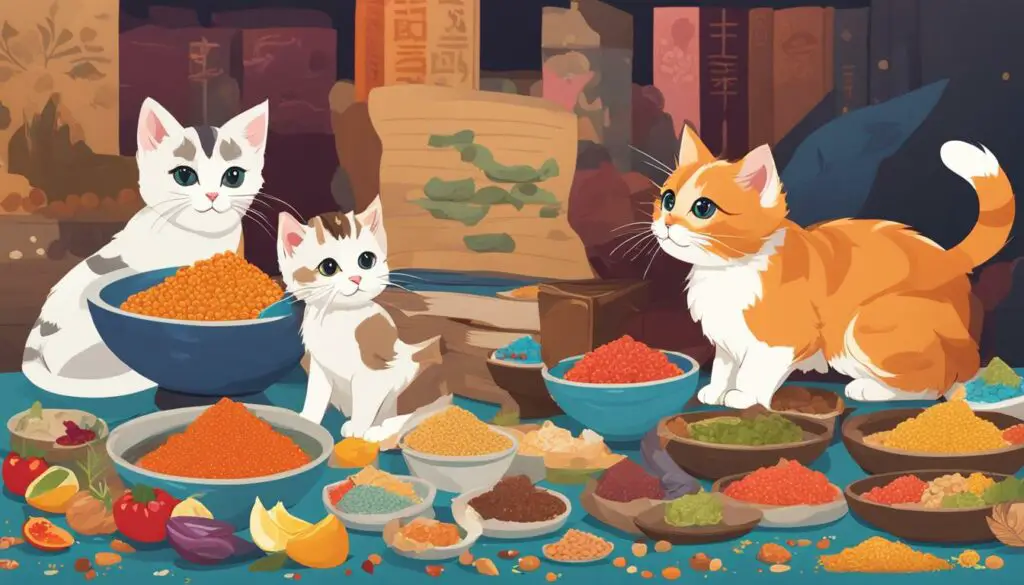
Preventing Maximal Growth and Obesity in Kittens
When it comes to ensuring the health and well-being of our kittens, preventing maximal growth and obesity should be a top priority. By practicing portion feeding, we can help our kittens maintain a healthy weight and promote optimal growth.
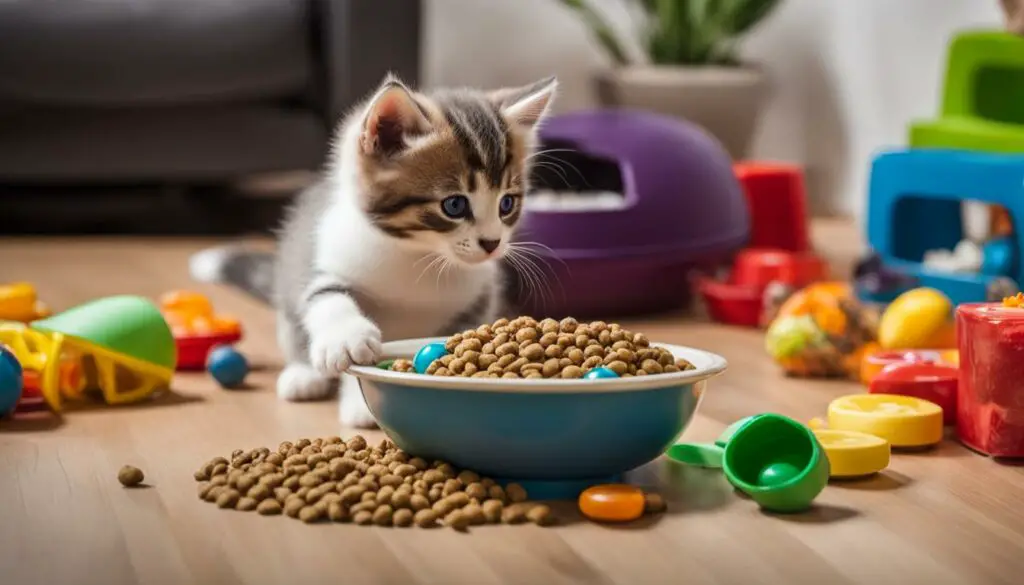
Portion feeding involves dividing the total daily portion of food into smaller, more frequent meals. This approach helps prevent overeating and allows the kitten’s body to process the nutrients more efficiently. It also helps regulate their energy levels throughout the day, keeping them active and playful.
In addition to portion feeding, it’s important to choose a high-quality kitten food that is specifically formulated for their nutritional needs. These foods provide the right balance of protein, fat, and essential nutrients to support healthy growth without excessive weight gain.
By implementing portion feeding and providing a balanced diet, we can give our kittens the best chance at a healthy and happy life. Regular monitoring of their weight and body condition, along with guidance from a veterinarian, can ensure that they are growing at an optimal rate.
Benefits of Portion Feeding for Kittens
Portion feeding offers several benefits for kittens, including:
- Prevention of overeating and obesity
- Better digestion and nutrient absorption
- Regulation of energy levels throughout the day
- Improved portion control and accurate feeding
- Promotion of healthy growth and development
By practicing portion feeding and providing a balanced diet, we can set our kittens up for a lifetime of good health and well-being. Taking the time to establish healthy eating habits early on will benefit them in the long run.
Table: Recommended Portion Feeding Guidelines for Kittens
| Age | Number of Meals per Day | Portion Size per Meal |
|---|---|---|
| 8-12 weeks | 4 | 1/4 – 1/3 cup |
| 3-6 months | 3 | 1/3 – 1/2 cup |
| 6-9 months | 2 | 1/2 – 3/4 cup |
| 9-12 months | 2 | 3/4 cup |
These portion sizes are general guidelines and may need to be adjusted based on the individual kitten’s activity level, metabolism, and overall health. Consulting with a veterinarian can provide personalized recommendations for your kitten’s specific needs.
Cats as Obligate Carnivores
Cats are fascinating creatures with unique dietary needs. Unlike humans and some other animals, cats are obligate carnivores, which means their bodies have evolved to require a diet primarily made up of meat. As obligate carnivores, cats have specific nutrient needs that can only be fulfilled by consuming animal tissue. This is due to their inability to efficiently digest and utilize nutrients from plant-based sources.
One key nutrient that cats require in their diet is protein. Protein is crucial for cats’ overall health and plays a vital role in their growth, development, and maintenance of lean muscle mass. Cats need high levels of dietary protein to meet their metabolic requirements and support various physiological functions.
In addition to protein, cats also require essential fatty acids, vitamins, and minerals that are found in animal tissue. These nutrients are essential for their overall well-being, including maintaining healthy skin and coat, supporting immune function, and promoting proper organ function.

Understanding cats’ unique dietary needs is crucial for providing them with the right nutrition. As responsible cat owners, it’s important to choose cat food that is specifically formulated to meet the nutrient needs of cats. High-quality commercial cat food that meets the nutritional guidelines set by organizations like AAFCO (Association of American Feed Control Officials) is recommended to ensure that cats receive the essential nutrients they need for optimal health.
Cats of Desert Origin
Cats are fascinating creatures that have adapted to various environments throughout history. One interesting fact about cats is that they are of desert origin. This means that their ancestors evolved in arid regions, where water is scarce. As a result, cats have developed unique traits and behaviors that enable them to conserve water and survive in these challenging conditions.
One important aspect of cats’ desert adaptation is their water intake. Cats have a lower daily water requirement compared to dogs of similar size. While it is still essential to provide fresh drinking water for domestic cats, it’s interesting to note that some cats get a significant portion of their water from their food. This is especially true for cats that consume moist or canned foods, which have higher water content compared to dry kibble.
“Cats’ natural feeding behavior involves grazing and eating small meals frequently throughout the day and night.”
Feeding behavior is another aspect influenced by cats’ desert origins. Cats have a unique way of consuming their meals that is different from other animals. They tend to graze and eat small meals frequently throughout the day and night. This behavior is a result of their adaptation to a diet consisting of small prey in their natural habitat. By eating this way, cats are able to conserve energy, prevent overeating, and mimic the natural hunting and feeding patterns of their ancestors.
Understanding cats’ desert origins and their specific water intake and feeding behavior can help pet owners provide the best care and nutrition for their feline companions. By offering a balanced diet that meets their nutrient needs and ensuring access to fresh drinking water, we can support cats’ natural adaptations and help them thrive in our homes.
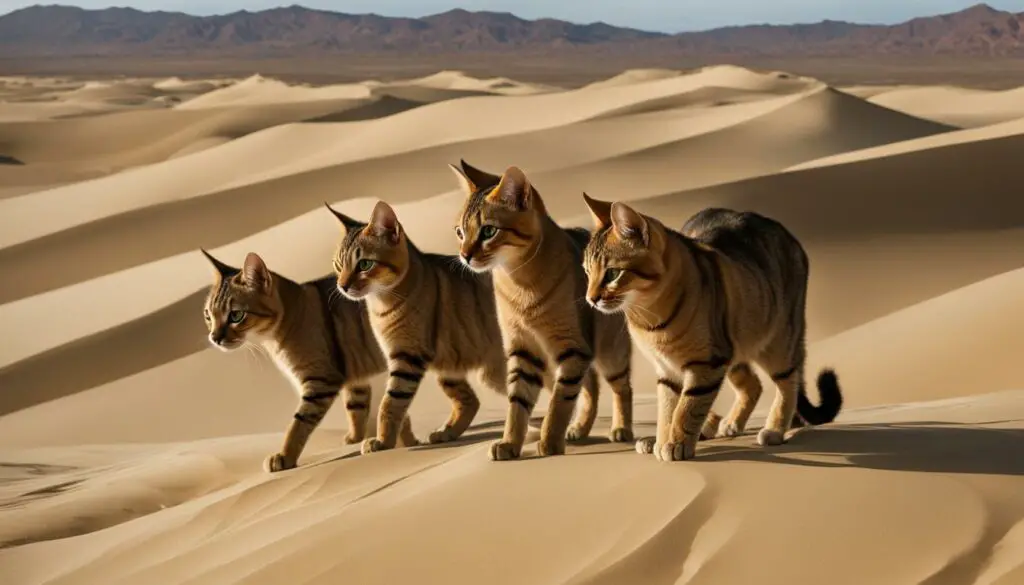
Practical Tips for Feeding Cats
Feeding cats is an essential responsibility for pet owners. To ensure your cat’s health and well-being, here are some practical tips for feeding them:
- Provide fresh water: Cats need access to clean drinking water at all times. Make sure to change the water regularly to keep it fresh.
- Follow a feeding schedule: Establish a regular feeding routine for your cat. Kittens may require more frequent meals, while adult cats can be fed twice a day. Stick to the feeding schedule to maintain consistency.
- Choose the right portion size: Avoid overfeeding by following the recommended guidelines for portion sizes. Overfeeding can lead to obesity and health issues. Consult with your veterinarian to determine the appropriate portion size for your cat’s age, breed, and activity level.
- Feed a balanced diet: Select high-quality commercial cat food that meets the nutritional guidelines set by the Association of American Feed Control Officials (AAFCO). These foods provide the necessary nutrients for your cat’s overall health.
Transitioning to a new food should be done gradually to avoid digestive upset. Mix a small amount of the new food with the old food, gradually increasing the proportion of the new food over several days.
Remember, each cat is unique, and their dietary needs may vary. Regular visits to the veterinarian can help ensure you are providing the right nutrition for your cat based on their individual requirements. By following these practical tips for feeding cats, you can contribute to their overall health and happiness.
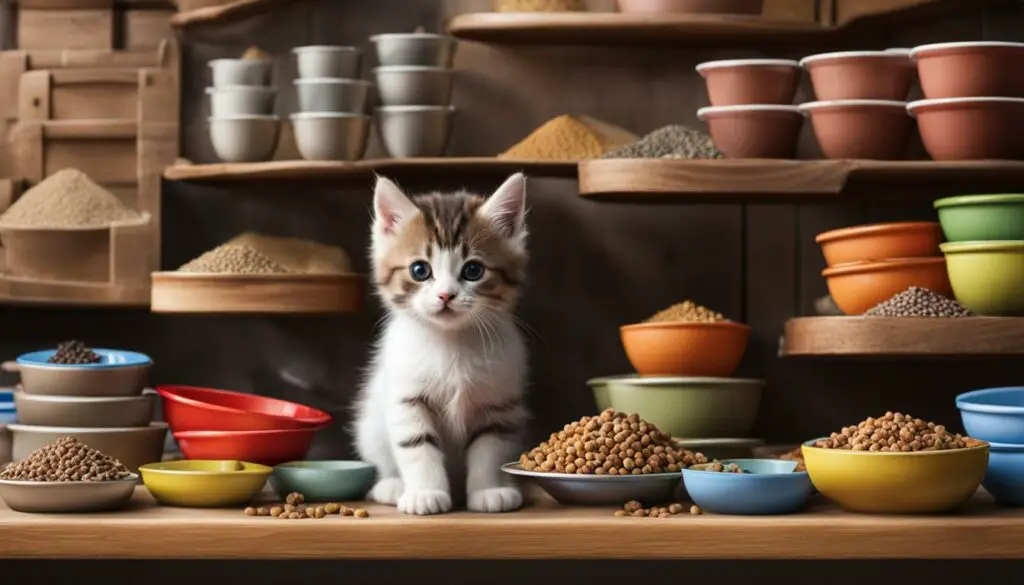
Feeding Schedule for Cats
| Age | Number of Meals |
|---|---|
| Kittens (up to 3 months) | 4-6 meals per day |
| Kittens (3-6 months) | 3 meals per day |
| Kittens (6-12 months) | 2-3 meals per day |
| Adult Cats | 2 meals per day |
The Importance of Choosing High-Quality Food for Cats
Choosing the right food for your cat is crucial for their overall health and well-being. High-quality cat food provides the necessary nutrients and helps prevent various health issues. When selecting cat food, it’s important to understand pet food labels and make informed decisions. Here are a few key points to consider:
- Look for a statement from AAFCO: The Association of American Feed Control Officials (AAFCO) sets nutritional standards for pet foods. Choose cat food that has an AAFCO statement on the label, indicating that it is “complete and balanced.” This ensures that the food meets the essential nutrient requirements for cats.
- Check the ingredients: High-quality cat food should contain high-quality ingredients. Look for named animal protein sources like chicken, turkey, or fish at the top of the ingredient list. Avoid foods that list generic terms like “meat” or “poultry by-products.”
- Avoid artificial additives: Artificial colors, flavors, and preservatives are unnecessary in cat food. Opt for food that uses natural ingredients and avoids synthetic additives.
By choosing high-quality cat food, you can provide your feline companion with the best possible nutrition. Remember, the health and well-being of your cat depend on the quality of their diet.
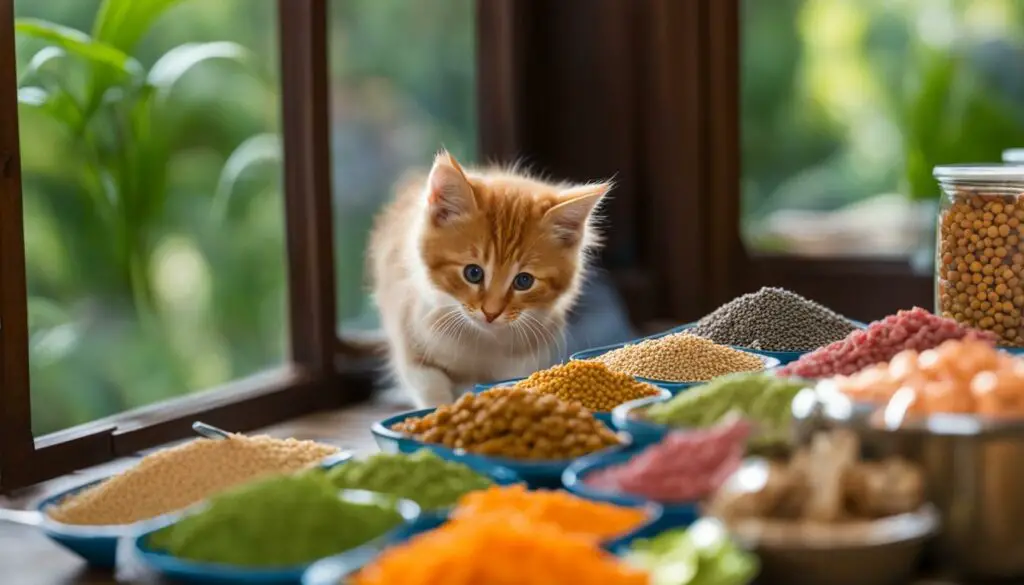
Understanding Pet Food Labels: Decoding the Terminology
Reading pet food labels can be confusing, but understanding the terminology can help you make more informed choices. Here are a few key terms to know:
Grain-free: This means the food doesn’t contain any grains like wheat, corn, or rice. Grain-free options can be beneficial for cats with allergies or sensitivities to grains.
Organic: Organic cat food is made with ingredients that are free from synthetic fertilizers, pesticides, and antibiotics. However, it’s important to note that organic doesn’t necessarily mean the food is nutritionally superior.
By-product: By-products are the parts of the animal that are not used for human consumption. While by-products can be a valuable source of nutrition for cats, it’s essential to ensure they come from high-quality sources.
Understanding these terms can help you navigate the pet food aisle with confidence and choose the best options for your cat’s health and well-being.
Feeding Guidelines for Kittens and Adult Cats
Feeding kittens and adult cats requires careful consideration of their nutritional needs. The frequency of feedings can vary based on their age and stage of life. For kittens, it is recommended to feed them small, frequent meals throughout the day to support their rapid growth and development. As they transition into adulthood, most cats can be fed two meals a day. However, it’s essential to follow the specific feeding guidelines provided by the pet food manufacturer to ensure they receive the appropriate amounts of nutrients.
When feeding kittens, it’s important to choose a diet that is specially formulated for their needs. Ideally, opt for canned or wet food, as it provides the necessary hydration for their small bodies. As kittens grow older, their teeth will develop, and they can transition to dry food if desired. Adult cats, on the other hand, can be fed a balanced diet of either wet or dry food, depending on their preferences and overall health.
It’s crucial to pay attention to portion sizes and avoid overfeeding. Obesity is a common issue that can lead to various health problems for cats. Consult with your veterinarian to determine the appropriate portion sizes based on your cat’s activity level and body condition. They can also provide guidance on whether a specific diet is necessary based on any underlying health conditions your cat may have. By following these feeding guidelines, you can ensure that your kittens and adult cats receive the proper nutrition they need for optimal health.
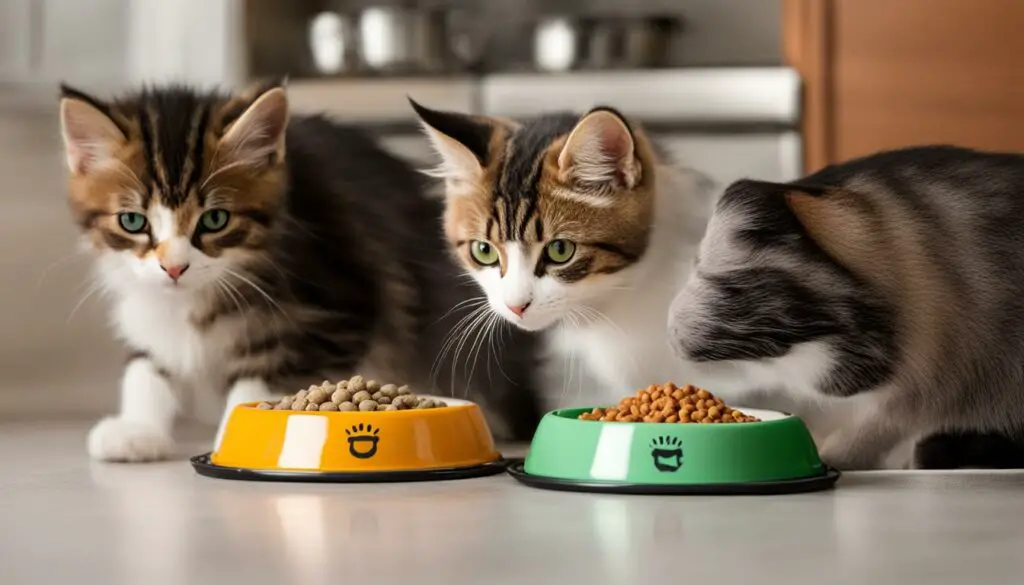
| Feeding Guidelines | Kittens | Adult Cats |
|---|---|---|
| Age | Up to 4 weeks | 12 months and older |
| Frequency | Every 2-3 hours | 2 meals per day |
| Portion Size | Follow guidelines on pet food label | Follow guidelines on pet food label |
| Food Type | Canned food or wet food | Wet or dry food |
Switching Cat Food
Switching your cat’s food can be a challenging task, as cats can be picky eaters and develop preferences for specific flavors and textures. However, there are some steps you can take to make the transition smoother and prevent digestive upset or refusal to eat.
To successfully switch your cat’s food, it is recommended to offer both the old and new food in separate bowls. This allows your cat to become familiar with the new food gradually. Start by offering a small amount of the new food alongside the old food, gradually increasing the proportion of the new food over several days. This slow transition helps your cat adjust to the new taste and texture without causing digestive issues.
It’s also important to note that sudden changes in a cat’s diet can lead to gastrointestinal upset. To minimize the risk, make any changes to your cat’s food gradually over a period of five to seven days. This will give your cat’s digestive system time to adapt and reduce the chances of stomach upset.
Remember to monitor your cat’s appetite and behavior during the transition. If you notice any signs of discomfort, such as vomiting or diarrhea, consult your veterinarian for guidance. They can provide tailored advice based on your cat’s specific needs and recommend the best approach for switching their food.
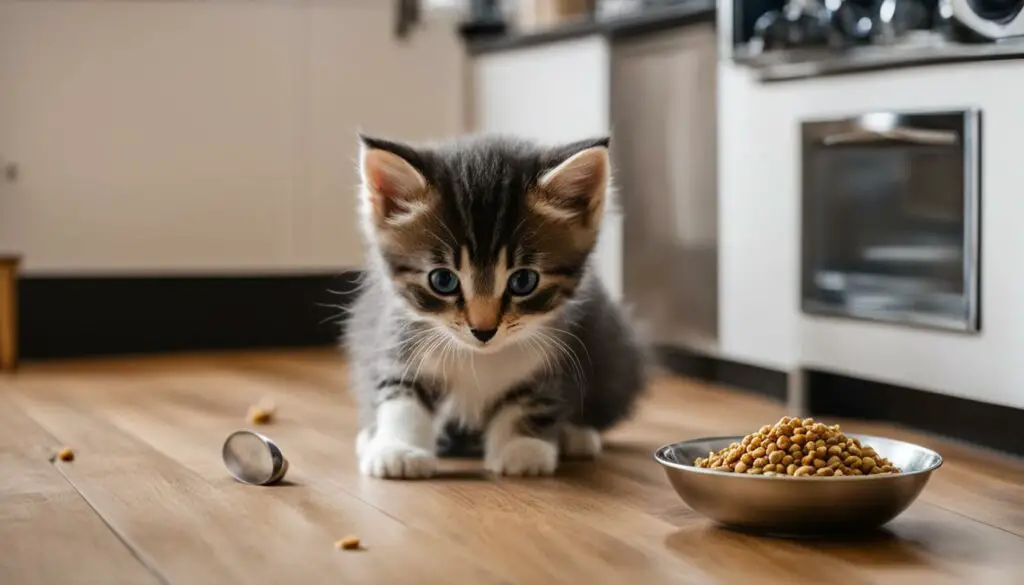
Avoiding Overfeeding and Obesity in Cats
Preventing overfeeding and obesity in cats is crucial for their overall health and well-being. Cats who are overweight or obese are at a higher risk for various health issues, including diabetes, arthritis, and heart disease. By practicing portion control and following a few simple guidelines, pet owners can help their feline companions maintain a healthy weight and live a longer, happier life.
Portion Control and Feeding Guidelines
One of the most important aspects of avoiding overfeeding in cats is practicing portion control. It’s essential to follow the feeding guidelines provided by the cat food manufacturer for the specific age and weight of the cat. These guidelines take into account the cat’s nutritional needs and help prevent excessive calorie intake. Additionally, it’s crucial to resist the temptation to over-treat cats with high-calorie snacks or table scraps. Treats should be given in moderation and should not exceed 10% of the cat’s daily caloric intake.
Feeding cats according to a schedule rather than free-choice feeding can also help prevent overeating and obesity. Dividing the cat’s daily portion into two or three meals throughout the day can help regulate their appetite and prevent them from consuming more than they need. It’s important to monitor the cat’s body condition regularly and adjust the portion size accordingly to maintain a healthy weight.
Exercise and Enrichment
In addition to portion control, providing opportunities for exercise and mental stimulation is crucial for preventing obesity in cats. Regular play sessions with interactive toys, such as feather wands or laser pointers, can help cats burn calories and maintain a healthy weight. Creating an enriched environment with scratching posts, climbing trees, and puzzle toys can also keep cats active and prevent them from overeating out of boredom.
Regular play sessions with interactive toys can help cats burn calories and maintain a healthy weight.
Consulting with a Veterinarian
If a cat is already overweight or obese, it’s important to consult with a veterinarian for a tailored weight loss plan. The veterinarian can provide guidance on appropriate portion sizes, recommend a balanced weight loss diet, and monitor the cat’s progress. They can also rule out any underlying medical conditions that may contribute to weight gain or hinder weight loss.
By implementing portion control, providing opportunities for exercise, and seeking professional guidance, pet owners can help their cats maintain a healthy weight and avoid the negative consequences of overfeeding and obesity. Remember, a healthy weight is essential for a cat’s overall well-being and longevity.
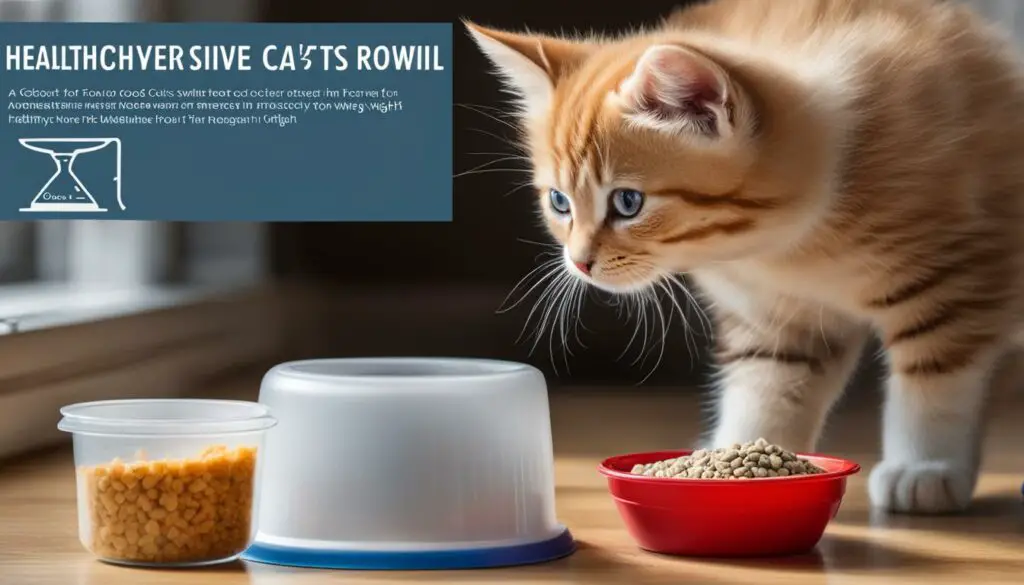
Choosing the Right Nutrition for Your Cat
When it comes to choosing the right nutrition for your cat, it’s important to consider their specific needs. Each cat is unique, with individual requirements based on factors such as age, breed, activity level, and overall health. By understanding these factors and selecting a diet that meets their specific needs, you can ensure optimal health and well-being for your feline friend.
To determine the right nutrition for your cat, start by considering their life stage. Kittens have different nutritional needs than adult cats, and senior cats may require specialized diets to support their aging bodies. Look for cat food labeled specifically for their life stage, such as “kitten,” “adult,” or “senior.”
Additionally, take into account any specific health conditions your cat may have. For example, if your cat has a sensitive stomach or food allergies, look for diets specifically formulated to address these issues. A consultation with a veterinary healthcare team can provide valuable guidance and recommendations for the best diet for your cat.
Remember, choosing the right nutrition for your cat is crucial for their overall health and well-being. By understanding their specific needs and selecting a diet tailored to them, you can provide them with the foundation for a happy and healthy life.
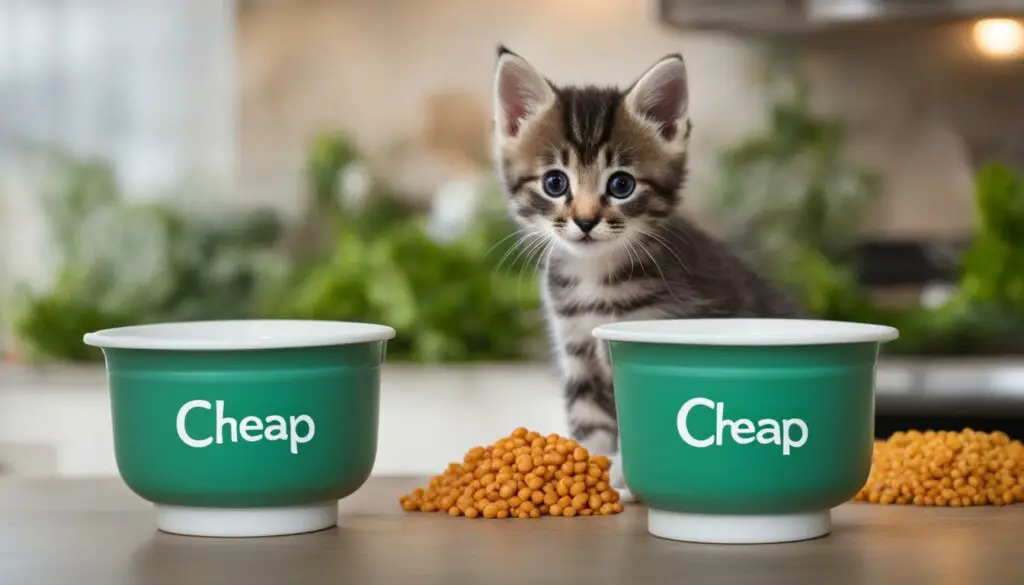
The Importance of Life Stage Diets
Just as humans have different nutritional needs at different stages of life, cats also require specific diets suitable for each life stage. Here is a breakdown of the different life stages and their corresponding nutritional requirements:
| Life Stage | Nutritional Requirements |
|---|---|
| Kitten | Higher protein and fat content for growth and development |
| Adult | Moderate protein and fat content to support maintenance |
| Senior | Lower calorie and fat content for weight management |
By feeding your cat a diet specifically formulated for their life stage, you can ensure they are receiving the appropriate nutrients to support their current needs. Remember to consult with your veterinarian to determine the best diet for your cat’s specific life stage and any unique health considerations.
Considering Individual Needs
While life stage is an important consideration when choosing your cat’s nutrition, it’s also vital to consider their individual needs. Factors such as breed, activity level, and overall health can impact their nutritional requirements.
- Breed: Certain breeds may have specific nutritional needs. For example, large breed cats may require diets formulated to support healthy bone and joint development.
- Activity Level: Cats with high activity levels may require higher calorie diets to meet their energy needs, while sedentary cats may need lower calorie options to prevent weight gain.
- Health Considerations: Cats with specific health conditions, such as kidney disease or urinary issues, may benefit from specialized diets designed to support their unique needs.
By taking these individual factors into account, you can select a diet that provides your cat with the necessary nutrients to thrive. Regular check-ups with your veterinarian can help ensure your cat’s nutritional needs are being met and address any specific concerns.
Conclusion
In conclusion, providing proper nutrition for our cats is crucial for their overall health and well-being. Whether we are feeding kittens or adult cats, it’s important to be mindful of their unique nutritional needs and prevent overfeeding. By understanding that cats are obligate carnivores and require high-quality protein, we can make informed decisions about their diet.
Preventing overfeeding is key in maintaining a healthy weight in cats and preventing obesity. Following recommended feeding guidelines and practicing portion control are essential. By offering the right amount of food based on our cat’s activity level and age, we can ensure they receive the appropriate number of calories.
Feeding kittens properly is especially important since they are growing rapidly. Providing them with a kitten formula until they reach one year of age and gradually transitioning to adult food can support their optimal growth and development.
In conclusion, prioritizing cat nutrition and understanding their specific needs can contribute to their long-term health and longevity. By consulting with a veterinary healthcare team and choosing high-quality cat food, we can provide the right nutrition for our feline friends and prevent overfeeding-related complications. Let’s give our cats the best chance at a healthy and happy life by nourishing them with the proper diet they deserve.
FAQ
Can you overfeed a kitten?
Yes, overfeeding a kitten can lead to obesity and other health complications.
What are the signs of overfeeding in kittens?
Signs of overfeeding in kittens can include rapid weight gain, a distended or bloated abdomen, and difficulty moving or playing.
How often should I feed my kitten?
Kittens should be fed multiple small meals throughout the day, typically three to four times, to prevent overfeeding and promote optimal growth.
What is the growth rate of kittens?
Kittens grow rapidly and reach adulthood by 10-12 months of age. Their growth rate slows as they approach 80% of adult size at around 30 weeks of age.
What is the difference between optimal and maximal growth in kittens?
Optimal growth in kittens refers to a slow and steady growth rate that allows them to achieve an ideal adult body condition. Maximal growth involves rapid growth due to high-fat foods, overfeeding, or free-choice feeding, which increases the risk of overweight or obesity in kittens.
What are the nutritional requirements for growing kittens?
Growing kittens require high levels of protein, fat, and calcium. The recommended protein range for healthy kitten growth is 35-50% on a dry matter basis. Fat content should be around 18-35% on a dry matter basis. Calcium requirements range from 0.8-1.6% on a dry matter basis.
How can I prevent maximal growth and obesity in kittens?
Preventing maximal growth and obesity in kittens involves portion feeding and regular assessments of body condition and weight. Following recommended feeding guidelines and seeking guidance from a veterinarian can help ensure kittens are growing at an optimal rate.
Why are cats considered obligate carnivores?
Cats are considered obligate carnivores because they require meat in their diet to fulfill their specific nutritional needs. They lack the metabolism to properly digest vegetable matter.
How much water do cats need to drink?
Cats can drink less water per day than dogs of similar size. While fresh drinking water should always be available, some cats may get most of their water from their food, especially moist or canned foods.
How often should I feed my cat?
Adult cats can be fed 2 meals a day, while young kittens need to eat more frequently. Feeding schedules can vary based on the cat’s age and preferences.
How do I choose high-quality food for my cat?
When choosing cat food, look for a statement from AAFCO on the label indicating that it is “complete and balanced.” It’s best to select high-quality cat food from a trusted source, ideally recommended by a veterinarian.
How do I switch my cat’s food?
When switching cat food, offer both old and new food in separate bowls to allow for a gradual transition. Changes should be made gradually over five to seven days to prevent digestive upset.
How can I prevent overfeeding and obesity in my cat?
Following recommended feeding guidelines, practicing portion control, and providing ample opportunities for exercise can help prevent overfeeding and obesity in cats.
What should I consider when choosing the right nutrition for my cat?
Each cat has unique nutritional needs and preferences. Factors such as age, breed, activity level, and overall health should be considered when choosing the right nutrition for your cat.
Source Links
- https://vcahospitals.com/know-your-pet/nutrition-feeding-guidelines-for-cats
- https://vcahospitals.com/know-your-pet/feeding-growing-kittens
- https://www.alltech.com/guide-feeding-kittens

